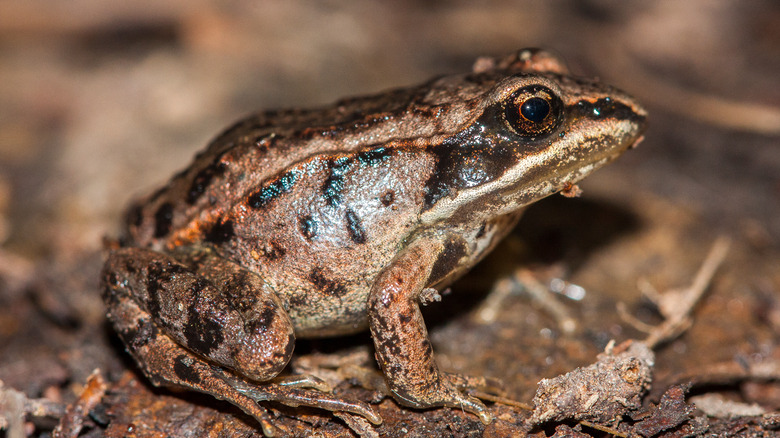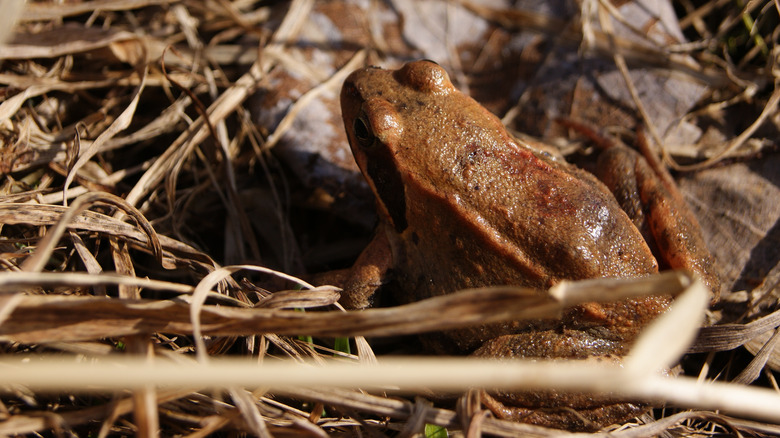The Frog That Can Hold In Its Pee For Up To 8 Months
According to Science Focus, the maximum time a human being can hold in their urine is 36 hours. Despite this, Insider reports that a person will have the urge to desperately use the bathroom within nine to 10 hours of holding it in. After that, it's likely that an individual will simply pee their pants. For reference, Healthline explains that the human bladder produces up to 2,000 millimeters of urine a day. However, it can only hold 400 to 600 millimeters of urine at a time. Currently, there is no record set for the longest time someone has held it in.
That being said, there is an animal that can hold it in for an inordinate amount of time. Phys writes that wood frogs go up to eight months without having to pee. This distinct amphibian is only three inches long and can be found in the forests of Canada, Alaska, and New England (via New Hampshire PBS). Moreover, wood frogs come in shades of brown, gray, and red. They are also known for the black markings on their face that are referred to as a "robber's mask."
The National Wildlife Federation states that they eat insects, worms, and more. Even so, this is not an average frog. These tiny creatures survive harsh temperatures during the wintertime by practically freezing themselves to death (per Phys).
This is how wood frogs survive freezing temperatures
As Nature explains, wood frogs freeze themselves while they hibernate during winter. Impressively, their temperature can plummet to zero degrees (via Phys). Jon Costanzo, a zoologist at Miami University states that "Their eyes are white. Their skin is frosty. They're like little rocks. They're frozen." Simply put, the frogs look dead but that isn't the case thanks to their urine. With the start of the winter season, the urea levels in wood frogs increase and they stop urinating as they begin to hibernate.
RxList reports that urea is a substance that is filtered out from blood and into the kidneys. The body then disposes of it through urine. Cleveland Clinic states that in humans, urea buildup can be toxic and is often an indicator of kidney disease. However, in wood frogs, the elevated quantities of urea are not dangerous to them. In fact, the urea is essential in keeping them alive while they are frozen. As Costanzo explains "Urea protects cells and tissues, even as the critters' hearts, brains, and bloodstreams stop" (per MEL Magazine). Besides urea, there is another component that is crucial to the survival of wood frogs while they hibernate: nitrogen.
The nitrogen in their urine is key
According to Phys, wood frogs don't urinate while they hibernate in order to transform the urea into nitrogen. Ultimately, this is what cushions their insides and prevents them from dying while they freeze themselves (via Vernon Morning Star). MEL Magazine states that wood frogs are able to reprocess their urea into nitrogen thanks to Pseudomonas, a bacteria that is found in their gut. It's for this very reason that the frog's urine is often referred to as antifreeze.
When they hibernate, New Hampshire PBS explains that wood frogs seek shelter and subsequently begin the freezing process. Although their heart and their breathing stop, The National Wildlife Federation writes that this "antifreeze" prevents the cold winter temperatures from freezing the frog's cells, which would kill them. Once February or March rolls around, the wood frogs thaw and set out to breed.
Jon Costanzo told Phys that "any animal that allows itself to freeze solid and is able to recover from it and walk away and thus go about its business like nothing happened, to me that's about as cool as it gets." Per The National Wildlife Federation, wood frogs, however, are not invincible. They have a short life span of only three years.


